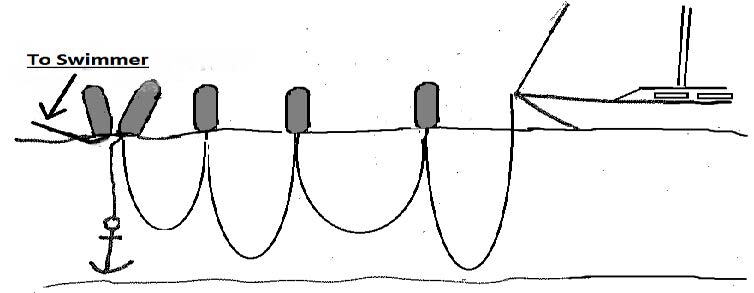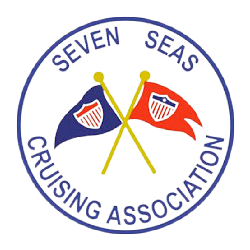Few boats come adequately outfitted with all of the necessary equipment and gear for anchoring in all conditions, or in any type of bottom that the crew might encounter. Making the boat so-equipped should be a top priority for the new owner, and this includes the ability to deploy and retrieve the biggest, heaviest, or the most awkward-to-handle anchors.
Deploying
Good technique for deploying your anchor is as follows: Position the boat, halt forward momentum, and as sternway is gained, lower the anchor to the seabed. Deploy an appropriate length of rode (scope), install a snubber or bridle, then back down (set) on the anchor. When finished be certain to secure the rode so it doesn't continue to slide out. Don't forget to hang the mandated day shape, or for night or restricted visibility, the anchor light.
Other Thoughts
-
When entering unfamiliar anchorages, go slow; maybe sound your way in.
-
Prior to deploying the anchor, consider checking the depths of the water, not only where the boat will initially be anchored, but also in areas where the wind or current might swing the boat.
-
Keep in mind that the depth of water may go down, due to such things as tide, wind, or in dam controlled waterways, the water being let out. Allow for this change in depth if it is a possibility.
-
Prior to letting go the anchor, if practical, head up into the wind or current, whichever has the greatest influence on the boat. If you're not sure, stop the boat to see which direction it drifts.
-
Though the anchor can be lowered before the boat's forward momentum has stopped, it is best to not allow the anchor to reach the seabed until all forward momentum has ceased.
-
Deploying the anchor by just tossing it overboard, though rightly frowned upon, is acceptable if it is brought back to the surface, cleared it if fouled, then lowered to the seabed.
-
Anchors can be deployed from any amiable location on the boat, with the rode lead fair to where it will be belayed.
-
If the boat has too little power to set the anchor with maximum rode, instead, set the anchor with a "short" scope, approximately 4:1. Once the anchor is set, additional rode can then be veered.
-
For a hard bottom, a scope of 7:1 or more may be necessary to get an anchor's flukes to dig in. In a soft bottom, some anchors, in order for their flukes to dig in need a shorter scope, 3:1 or even 2:1. In a rock bottom, no amount of scope will allow an anchor's flukes to dig into an impenetrable bottom like this.
-
When using the engine to back down on the anchor, increase the load on the anchor slowly.
-
In determining how hard to back down on the anchor, think in terms of a "sliding scale"–use the amount of force that is commensurate with the anticipated conditions. For example, if the conditions are mild, the length of time to be at anchor will be short, and the crew remaining aware of the weather, backing down "very lightly" on the anchor may be acceptable. On the other hand, if the conditions are or will be "heavier", back down on the anchor as hard as is necessary to insure that the anchor is set well enough for those conditions.
-
When getting out an additional anchor with the "big" boat is impractical, anchors can be taken out by dinghy. The dinghy can be rowed or powered, though with much wind or current, rowing might not be a viable option. (For the various patterns that multiple anchors can be arranged, see Appendix 7.)
-
When an anchor is deployed by dinghy, the rode can be towed away from the main vessel, a good choice when wind or current is favorable. The other alternative, especially when wind or current is against you, is to load the anchor and the entire rode into the dinghy, position and drop the anchor, then pay out the rode from the dinghy as it returns to the main vessel. In this latter method, carrying a float or extra line in the dinghy could be helpful in case the rode comes up short.
-
Two or more dinghies working in tandem can be used to deploy an anchor. The anchor is worked from the rear dinghy, while the front dinghy provides power and steerage. This is a particularly effective method to use when strong currents are running or the wind is up.
-
When getting additional anchors out by dinghy is just not practical or safe, consider using fenders, cushions, or enough other items with sufficient flotation to support the anchor and the large loops of rode that follow. The anchor and rode need only float high enough to keep them from dragging on the bottom. Then, using your mask, fins, and snorkel, swim the gear out into place. In cold water, a wet suit might be a welcome addition to this gear. If the flotation pendants are attached by a slipped knot the gear is easier to let go.

-
Getting an anchor of size overboard, one not housed on a roller, cathead, or in a hawse pipe, may require a windlass, winch, davit, or boom, plus any associated tackle, turning blocks, or other contrivances, as well as some ingenuity, and maybe an additional crew member(s). Make these arrangements ahead of time.
-
If the anchor may become fouled, prior to deployment attach a trip line or scow the anchor.
Find more anchoring advice in ANCHORING-A Ground Tackler's Apprentice by Rudy and Jill Sechez, available at Waterway Guide Ship Store- and now in the Waterway Guide Mobile App!













